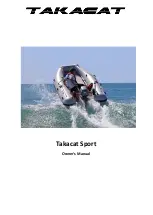
Raw Water System
Completely drain the raw water systems. Disconnect
all hoses and blow the water from the system. Use
only very low air pressure when doing this to
prevent possible system damage. Because of the
check valve mechanism built in the raw water
washdown and livewell pumps, blowing the lines will
not remove the water from that raw water pump.
Remove the outlet hose on the pump. Turn the
pump on and allow it to pump out any remaining
water....about a cupful. A recommended alternative
to the above-mentioned procedure is the use of
commercially available non toxic, potable water
system antifreeze. If potable water antifreeze is
used, pour the mixture into a pail and put the raw
water intake lines into the solution. Run the pumps
one at a time until the antifreeze solution is visible at
all raw water faucets, discharge fittings and drains.
Be sure antifreeze has flowed through all of the raw
water drains.
Outboard Engines
The engine(s) should be flushed with freshwater for
at least 15 minutes prior to winter storage. This will
remove salt, sand and other contaminates that can
damage the engine. It is also important to “Fog” the
cylinders, change the gear oil, fill the oil tanks (2-
cycle engines) or change the oil in 4-cycle engines,
coat the engine with a protectant, wax the exterior
and properly store and charge the battery. You
should refer to the engine owner’s manual or
contact your dealer for specific instructions on
winterizing your engines.
Marine Toilet
The marine toilet must be properly winterized by
following the manufacturer’s winterizing instructions
in the marine toilet owner’s manual. Drain the intake
and discharge hoses completely using low air
pressure if necessary. The head holding tank and
overboard discharge pump must be pumped dry and
three gallons of potable water antifreeze poured into
the tank through the deck waste pump out fitting.
After the antifreeze has been added to the holding
tank, open the overboard discharge valve and
activate the discharge pump until the antifreeze
solution is visible at the discharge thru-hull.
Note: Make sure you follow the marine toilet
manufacturer’s winterizing instructions
exactly.
Bilge
Coat all metal components, wire busses, and
connector plugs in the bilge with a protecting oil. It
is also important to protect all strainers, seacocks
and steering components. The bilge pumps and
bilge pump lines must be completely free of water
and dried out when the boat is laid up for the winter
in climates where freezing occurs. Compartments in
the bilge that will not drain completely should be
pumped out and then sponged until completely free
of water. Dry the hull
bilge and self-bailing cockpit troughs. Water freezing
in these areas could cause damage.
Seacocks
Most seacocks are winterized when the systems they
serve are winterized. Check to make sure each
seacock has been winterized and that the valve is
open to allow the water to drain out of the valve.
Water freezing in seacocks will damage the valves.
Hardtop
It is imperative that all drain holes in the legs are
open and that the legs are completely free of water.
Remove the enclosure and thoroughly clean and
store in a safe, dry place. Remove all electronics.
Coat all wire connectors and bus bars in the helm
compartment with a protecting oil.
Clean the aluminum frame with soap and water and
dry thoroughly. Apply an aluminum metal protectant
to the entire frame to reduce corrosion and pitting.
Special Notes Prior To Winter Storage
If the boat will be in outside storage, properly
support a storage cover and secure it over the boat.
It is best to have a frame built over the boat to
support the canvas. It should be a few inches wider
than the boat so the canvas will clear the rails and
allow passage of air. If this cover is fastened too
tightly there will be inadequate ventilation and this
can lead to mildew, moisture accumulation, etc. It is
essential to fasten the canvas down securely so that
the wind cannot remove it or cause chafing of the
hull superstructure. Do not store the boat in a damp
storage enclosure. Excessive dampness can cause
electrical problems, corrosion, and excessive mildew.
Whenever possible, do not use the enclosure
curtains in place of the winter storage cover. The life
of these curtains may be significantly shortened if
exposed to harsh weather elements for long periods.
62
Содержание 232 Coastal
Страница 1: ...232 252 Coastal OWNER S MANUAL Wellcraft Marine Corp 1651 Whitfield Ave Sarasota FL 34243...
Страница 2: ...2...
Страница 4: ...4...
Страница 7: ...232 COASTAL SPECIFICATIONS 7...
Страница 8: ...252 COASTAL SPECIFICATIONS 8...
Страница 16: ...16...
Страница 43: ...232 COASTAL SAFETY LABELS 2601 1124 2601 1094 43...
Страница 44: ...252 COASTAL SAFETY LABELS 2601 1124 2601 1094 44...
Страница 45: ...232 252 COASTAL CAPACITY LABELS 45...
Страница 64: ...Appendix A SCHEMATICS 232 COASTAL INSTRUMENT PANEL 64...
Страница 65: ...Appendix A SCHEMATICS 232 COASTAL HELM SWITCH PANEL 65...
Страница 66: ...Appendix A SCHEMATICS 232 COASTAL BREAKER BOX PANEL 66...
Страница 67: ...Appendix A SCHEMATICS 232 COASTAL WIRING HARNESS 67...
Страница 68: ...Appendix A SCHEMATICS 252 COASTAL INSTRUMENT PANEL 68...
Страница 69: ...Appendix A SCHEMATICS 252 COASTAL HELM SWITCH PANEL 69...
Страница 70: ...Appendix A SCHEMATICS 252 COASTAL BATTERY SWITCH PANEL 70...
Страница 71: ...Appendix A SCHEMATICS 252 COASTAL WIRING HARNESS 71...
Страница 76: ...Appendix A 232 COASTAL OVERHEAD LAYOUT 76...
Страница 77: ...Appendix A 252 COASTAL OVERHEAD LAYOUT 77...
Страница 78: ...Appendix A SCHEMATICS 232 COASTAL TRAILER SCHEMATIC 78...
Страница 79: ...Appendix A SCHEMATICS 252 COASTAL TRAILER SCHEMATIC 79...
Страница 83: ...MAINTENANCE LOG 83...
Страница 84: ...MAINTENANCE LOG 84...
Страница 86: ...Appendix D BOAT ACCIDENT REPORT 86...
Страница 87: ...87...
Страница 93: ...Appendix F TROUBLESHOOTING GUIDE 93...
Страница 94: ...TROUBLESHOOTING GUIDE 94...
Страница 95: ...TROUBLESHOOTING GUIDE 95...
Страница 96: ...TROUBLESHOOTING GUIDE 96...
Страница 97: ...TROUBLESHOOTING GUIDE 97...
















































